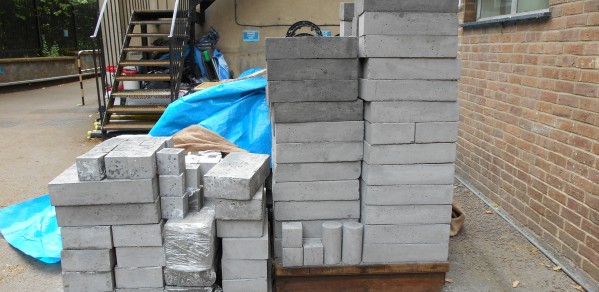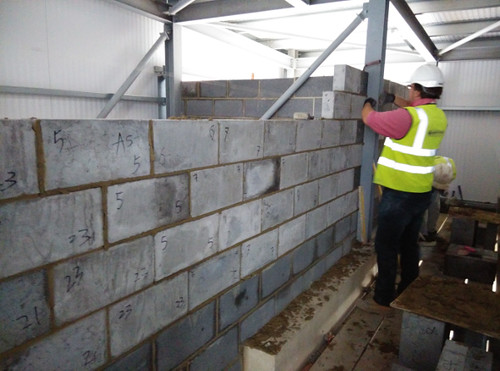
During construction of the James Dyson Building, novel innovations in cement and concrete developed at the Department of Engineering are being field-tested at full scale.
As the James Dyson Building, located at the Trumpington site of the Department, nears completion, the products of research from the Department are given an opportunity to be put to use in the real world. For example, wall sections in the plantroom on the roof have been built from lightweight concrete blocks. In total, 200 of these full-size blocks were hand-manufactured at the Department and many are almost completely made out of industrial by-products. The blocks contain a wide range of innovative cements, aggregates and additives including self-healing concrete, crack-free concrete, ‘clinkerless’ cement concrete and waste-based concrete.
The blocks are the efforts of a number of researchers working with Professor Abir Al-Tabbaa, Professor of Civil and Environmental Engineering. They include Dr Antonis Kanellopoulos, Dr Fei Jin, Chrysoula Litina, Yuk Lau, Ahmed Abdalqader, Tanvir Qureshi, Rami Alghamri, Petros Giannaros, Livia Souza, Wenting Mao and Phil Muff. The focus of these developments is on sustainability in terms of low carbon footprints as well as enhanced performance, durability and longevity.
“The work at the James Dyson Building provides a very exciting opportunity,” said Professor Al-Tabbaa. “Not only for the large number of researchers involved to test their research ideas and developments at full-scale, but so that a legacy is left for future researchers to test over the longer term.” A second phase of concrete developments is planned and will include the installation of a number of large wall panels along other wall sections within the plantroom.
The blocks were installed in September and the researchers will shortly begin the time-related monitoring and testing process of those wall sections to provide new data for their projects. Performance will be assessed with in-situ measurements including volume stability, strength, air permeability and various durability aspects. In addition, the self-healing blocks will be subjected to various damage scenarios (these are non-structural wall elements) and the self-repair process and crack closure will be assessed using ultrasonic measurements and microscopic analysis of the cracks.
Together with parallel, larger-scale trials at other commercial project locations within the UK, Al-Tabbaa hopes the researchers’ investigations will pave the way for enhanced scientific understanding of the performance of the in-situ materials and products and the development of more sustainable construction materials in the future.
Gallery: Advanced concrete blocks at the James Dyson Building
Credit: Antonis Kanellopoulos


